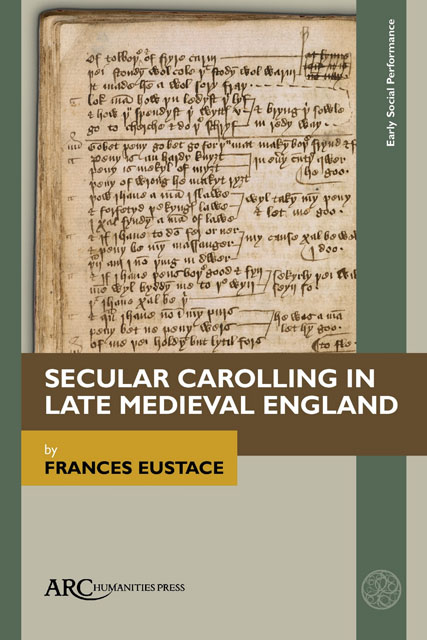Book contents
- Frontmatter
- Contents
- List of Illustrations
- Preface
- Introduction
- Chapter 1 Carolling and Dance-Song in the Context of a Primarily Oral Culture
- Chapter 2 Courtly Carolling: Contexts and Practices
- Chapter 3 The Church, Carolling, and the Emergence of the English Franciscan Carole Writers of The Fourteenth and Fifteenth Centuries
- Chapter 4 Carole Texts in Context: The Manuscripts
- Chapter 5 Carole Texts as Witnesses to Carolling Practice
- Chapter 6 Survivances Of Carolling In Folk Culture
- Conclusion: Carolling from a Dance Movement Psychotherapy Perspective
- Bibliography
- Index
Chapter 1 - Carolling and Dance-Song in the Context of a Primarily Oral Culture
Published online by Cambridge University Press: 06 April 2023
- Frontmatter
- Contents
- List of Illustrations
- Preface
- Introduction
- Chapter 1 Carolling and Dance-Song in the Context of a Primarily Oral Culture
- Chapter 2 Courtly Carolling: Contexts and Practices
- Chapter 3 The Church, Carolling, and the Emergence of the English Franciscan Carole Writers of The Fourteenth and Fifteenth Centuries
- Chapter 4 Carole Texts in Context: The Manuscripts
- Chapter 5 Carole Texts as Witnesses to Carolling Practice
- Chapter 6 Survivances Of Carolling In Folk Culture
- Conclusion: Carolling from a Dance Movement Psychotherapy Perspective
- Bibliography
- Index
Summary
CAROLLING WAS FUNDAMENTALLY an orally transmitted cultural activity. Dance-songs, or caroles, existed within the context of the communal song culture of medieval society at all levels. Not only did caroles exist before any extant examples were written down, but many also circulated long after in a parallel oral culture, even within a predominantly literacy-dependant society. Just as music history is the history of the written record not of music itself, a carole recorded in a scene of carolling in a romance narrative is not the thing itself, just as a set of variations on Cotton Patch Rag published in a Bluegrass Fiddle Styles book is not Bluegrass Fiddling. Caroles have been brought to the attention of scholars by their presence in medieval literature and sermons, and by the later recording of texts as poems, but the originals belong to a song culture that accompanied many activities of daily living and has left virtually no trace. As early as the fourth century ce, St. John Chrysostom offers a summary of this widely acknowledged tradition:
…travellers also sing as they drive their yoked animals at midday, thus lightening the hardships of the journey by their chants. And not only travellers, but peasants are accustomed to sing as they tread the grapes in the winepress, gather the vintage, tend the vine, and perform their other tasks. Sailors do likewise, pulling at the oars. Women, too, weaving and parting the tangled threads with the shuttle, often sing a particular melody, sometimes individually and to themselves, sometimes all together in concert.
Only fragments remain in a written record dating from the fourteenth century, distorted by the influence of the Church on book production and by the vagaries of the survival of any text from that period. The picture of the oral vernacular culture, portrayed by the written record, is as tantalizingly fleeting as the sparkle of a speck of gold in a prospector’s pan. The study of caroles and carolling needs to shake off the written tradition to bring this predominantly oral, secular song culture that existed throughout the Middle-Ages into a new focus. In this opening chapter, however, we take a swift overview of source texts relating to carolling, that evidence the existence of that oral culture and provide a context for understanding the relationship between oral and written cultures in a developing literate society.
- Type
- Chapter
- Information
- Secular Carolling in Late Medieval England , pp. 5 - 14Publisher: Amsterdam University PressPrint publication year: 2022



